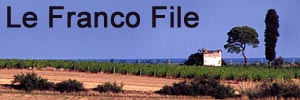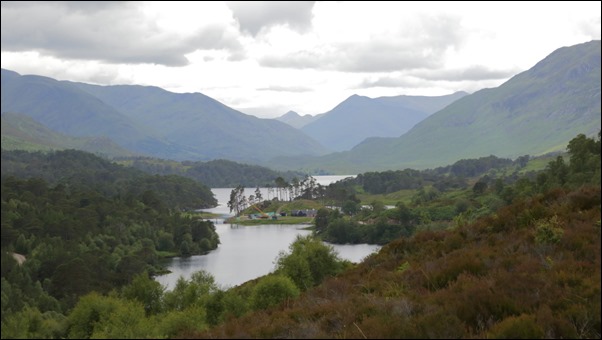Today we moved on from Poolewe, 25 miles down Loch Maree to the Caravan Club site at Kinlochewe, which had been my originally planned centre for hunting the Azure Hawker (Aeshna caerulea). Moving Guillaume occupied us for the morning. Checking in to the Kinlochewe site after the delightful Camping and Caravanning Club’s Inverewe Gardens site at Poolewe was a bit of a shock. Even though our Inverewe Gardens pitch was hard standing, the site had a grandstand view of Loch Ewe and all intervening spaces were grass. Now at Kinlochewe, we were faced with a campsite that was not just hard standing but hard everything.; each of the five or six enclaves were entirely gravel, not just gravel where the vans stood. It was like camping in a car park. We both felt disheartened. I would happily have dragged Guillaume the 25 miles back to Poolewe. Our feelings were not helped by the fact that we had packed up in brighter conditions at Poolewe, driven in those bright conditions for at least 20 of the 25 miles, then hit leaden skies with little light as we approach Kinlochewe. Still, it was new, gave us a couple more valleys to explore and gave us easier access to the hunting grounds. It’s also 25 miles closer to escaping Scotland. 😉
 Francine had arranged to meet our allies, Pablo and Susana, in the Beinn Eighe Visitor Centre at 13:00. Once Guillaume was set up, we crunched our way across the expanse of grey gravel and drove about 1 mile to our rendez-vous. Pablo was off trying to get his Wellington boot stuck in a Scottish bog while Susana waited to meet us. We investigated the cloud-shaded track from the visitor centre first. On the way out we saw nothing – hardly surprising – but having turned to return hawk-eyes Francine spotted a Common Goldenring (Cordulegaster boltonii) hung up low down sheltering from the wind in the heather. It gave us something to do with our cameras and, as I said, they are always a thrill for me not being one of my home team.
Francine had arranged to meet our allies, Pablo and Susana, in the Beinn Eighe Visitor Centre at 13:00. Once Guillaume was set up, we crunched our way across the expanse of grey gravel and drove about 1 mile to our rendez-vous. Pablo was off trying to get his Wellington boot stuck in a Scottish bog while Susana waited to meet us. We investigated the cloud-shaded track from the visitor centre first. On the way out we saw nothing – hardly surprising – but having turned to return hawk-eyes Francine spotted a Common Goldenring (Cordulegaster boltonii) hung up low down sheltering from the wind in the heather. It gave us something to do with our cameras and, as I said, they are always a thrill for me not being one of my home team.
We returned to the car park through mizzle and set off to a second Beinn Eighe car park to show Pablo and Susana the boggy area we’d eventually found at the end of the Woodland Trail a few days earlier. We spared them the unnecessary height gain followed by a descent and took the more direct, flat route, by going “the wrong way” round the trail. In a stiff breeze under Beinn Eighe’s cloud, the story was a similar one: “not a creature stirred, not even a mouse”.
The Poolewe end of Loch Maree still looked brighter. [BUGGER!] We drove back in that direction to see what transpired. Approaching Slattadale, life looked brighter, if not actually sunny, so we called in to see if we could improve our luck. We (Pablo and I) both knew the trail to walk up but Pablo had read something that spoke of “a glade on the left with logs”, that might be a profitable location. On the right, we did disturb a couple more Goldenrings but we were having trouble finding anything resembling a glade on the left. On the left was mostly thick bracken descending into a tumbling stream. We played with the Goldenrings again.
 Just after 16:30 the sun put in an appearance. Shortly afterwards, we found an area that could, possibly, with a little stretching of the imagination, be called a glade and there were certainly discarded sections of tree trunks in it, constituting, perhaps, logs. A dragonfly buzzed around and landed on the end of a log. I stood on a tree stump and snapped. I shouted, “there’s one here”. I fell off the tree stump in my excitement. Bother! [Or words to that effect.] I was inelegantly flat on my back amongst bracken and stumps, legs in the air, desperately clutching my camera and monopod to save them but I thought I’d got my own first shot of an Azure Hawker (Aeshna caerulea). The things we do for love. No herbage obscuring the beautiful critter anywhere – what a delightful beastie.
Just after 16:30 the sun put in an appearance. Shortly afterwards, we found an area that could, possibly, with a little stretching of the imagination, be called a glade and there were certainly discarded sections of tree trunks in it, constituting, perhaps, logs. A dragonfly buzzed around and landed on the end of a log. I stood on a tree stump and snapped. I shouted, “there’s one here”. I fell off the tree stump in my excitement. Bother! [Or words to that effect.] I was inelegantly flat on my back amongst bracken and stumps, legs in the air, desperately clutching my camera and monopod to save them but I thought I’d got my own first shot of an Azure Hawker (Aeshna caerulea). The things we do for love. No herbage obscuring the beautiful critter anywhere – what a delightful beastie.

 My compatriots joined me as I extricated myself from my ungracious position, with Francine’s help. There were actually two individual Azure Hawkers flying about and settling occasionally. One had a sideways-distorted abdomen. The other was a fine specimen and turned out to be quite a showman. It began by making it impossible for Francine to snag a picture by settling on her hand, beside her camera. A while later, it settled on Francine’s bum. Pablo could hardly believe he was zooming in on Francine’s bum. Eventually it settled on each one of us. In cooler weather Azure Hawkers have a reputation for settling on rocks to bask and soak up heat. This beauty was clearly borrowing warmth from our mammalian bodies. When it settled on Pablo, he could hardly contain himself.
My compatriots joined me as I extricated myself from my ungracious position, with Francine’s help. There were actually two individual Azure Hawkers flying about and settling occasionally. One had a sideways-distorted abdomen. The other was a fine specimen and turned out to be quite a showman. It began by making it impossible for Francine to snag a picture by settling on her hand, beside her camera. A while later, it settled on Francine’s bum. Pablo could hardly believe he was zooming in on Francine’s bum. Eventually it settled on each one of us. In cooler weather Azure Hawkers have a reputation for settling on rocks to bask and soak up heat. This beauty was clearly borrowing warmth from our mammalian bodies. When it settled on Pablo, he could hardly contain himself.
 The sun remained and our friendly Azure Hawker continued to fly sorties but return to our “glade with logs”. I got one particularly interesting shot of it sitting on a curved section of bark, pressing the entire length of its abdomen down into the bark in an attempt, presumably, to increase the contact area and absorb as much heat as possible. I’d never witnessed this sort of position before.
The sun remained and our friendly Azure Hawker continued to fly sorties but return to our “glade with logs”. I got one particularly interesting shot of it sitting on a curved section of bark, pressing the entire length of its abdomen down into the bark in an attempt, presumably, to increase the contact area and absorb as much heat as possible. I’d never witnessed this sort of position before.
Target #2 well and truly achieved, even without a female. Pablo and Susana may have been staying in a naff hotel but I have never seen four such happy campers in all my life.
Right, targets #1 and #2 achieved, we can leave Scotland now, Oh, no, we have friends driving to Kinlochewe just to see us on Sunday.

 Much of the activity featured the ever-popular Broad Scarlet/Scarlet Darter (Crocothemis erythraea) which, in continental Europe, it’s easy to get blasé about, being as widespread and common as they are, but one shouldn’t, they really are quite striking. Here’s both a male and female.
Much of the activity featured the ever-popular Broad Scarlet/Scarlet Darter (Crocothemis erythraea) which, in continental Europe, it’s easy to get blasé about, being as widespread and common as they are, but one shouldn’t, they really are quite striking. Here’s both a male and female. 
 I’m pleased to say, keeping the Scarlets good company were several examples of one of my gaudy little personal favourites, teh deliciously pink Violet Dropwing/Violet-marked Darter (Trithemis annulata). I didn’t spot any females (which are not pink) but I did snag several cooperative males. A man can’t have too many Violet Dropwings. 🙂
I’m pleased to say, keeping the Scarlets good company were several examples of one of my gaudy little personal favourites, teh deliciously pink Violet Dropwing/Violet-marked Darter (Trithemis annulata). I didn’t spot any females (which are not pink) but I did snag several cooperative males. A man can’t have too many Violet Dropwings. 🙂


















Recent Comments